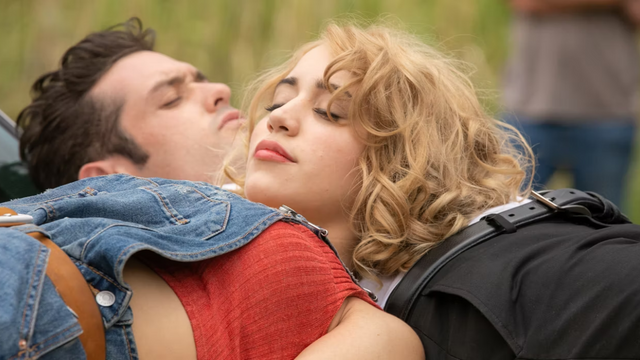If you’ve seen the ’90s classic, you’ll know it’s not the case. And neither is the road they travel on in Sean Patrick Flanery’s Frank & Penelope, an action-horror exploitation and road trip romance mash-up.
Frank and Penelope, Flanery’s debut film, features Kevin Dillon of Entourage and a cast of mostly newcomers, including Billy Budinich (Frank), Caylee Cowan (Penelope), and Sydney Scotia (Molly).
Frank, newly bereaved and aimless after witnessing his wife cheating, stumbles into a seedy sex club where Penelope is performing at the beginning of the story.
The stunning young stripper soon captures Frank’s heart and credit cards before the sting goes awry and she is forced to ride shotgun with the handsome stranger.
Frank and Penelope is an eclectic combination of influences and genres, with a seventies grindhouse style and plot elements drawn from old-school slashers. It pays particular attention to classic road flicks.
But with cheesy dialogue and a succession of apparently stupid decisions (why to spend the night in the spooky ghost town the sheriff of the county just advised them against? ), the film falls flat. The pair are less Bonnie and Clyde and dumber and Dumber.
After flying past the city limits and onto the wide-open highway surrounded by the Texan desert, Frank and Penelope begin to converse in the manner of people on a long automobile ride.
Frank and Penelope exhibit a major lack of chemistry for two conventionally handsome people without many clothes, which makes it difficult to understand Penelope’s unexpected attraction to Frank in the following moments.
Penelope declares her purportedly true affection for Frank in the same exaggerated language she just used to seduce and rob him, which does not help the story.
The combination of Frank’s meat-headed romantic and Penelope, a “stripper with a golden heart,” is so cloying that the introduction of cannibalistic murderers is a relief.
Consider The Hills to Have Eyes The citizens of “Quicksilver’s” dusty highway county have an interesting history similar to that of Terlingua, a real Texas town and the film’s actual locale.
Terlingua, like the mythical Quicksilver, was a thriving industrial center with America’s largest mercury mine. But as a result of the industry’s fast decline in the 1930s and 1940s, the mine went bankrupt and the town was nearly abandoned and is now regarded an official ghost town.
MUST READ: All Quiet on the Western Front Review: What is All Quiet on the Western Front’s Core Message?
It’s a fantastic location for the film’s vastly improved second act, and Flanery makes the most of it with wide-angle shots that capture the odd, frightening beauty of the desert’s fading sunset, burning low as the town’s few decaying buildings dissolve menacingly into the growing night.
“Get in and get out of there,” County Sheriff Caulfield (Kevin Dillion) instructs Frank and Penelope as they approach the forty-mile expanse of territory with no cell connection, before “those wild Appalachians” arrive. Instead, they promptly check into the “mad Appalachians'” scary guesthouse smack dab in the middle of nowhere. What could possibly fail?

What follows is a quick acceleration into schlocky, blood-soaked, pedal-to-the-metal violence that is absolutely disgusting, often makes no sense, and is by far the greatest portion of the film.
As the unofficial patriarch and matriarch of the murdering clan, Chisos and Mabel, played by Johnathon Schaech and Donna D’Errico, respectively, share equal brilliance as they take center stage, embracing the wicked characters with sufficient intelligence to be truly menacing.
(In a classic scene in which Frank and Penelope foolishly join the pair for a family dinner at a guesthouse, Chisos describes his sin-eating practice with a such quiet elegance that it sounds horrifyingly logical) Keven Dillon’s wonderfully convincing Deep South Daddy confidence amplifies the effect of Caulfield’s shocking character change, despite the fact that he has limited screen time.
Overall, there is a great deal to admire about this innovative action horror film. The issue is that whenever the action ceases, Frank and Penelope’s flaws become apparent.
Flanery’s attempts at slow-burn suspense are not always successful, and the longer the film takes to proceed, the more time the audience has to contemplate. This is not necessarily a good thing for a picture that, at its core, is no more intelligent than a mediocre blockbuster.
For example, I’m still trying to make sense of the film’s sexual politics, which are just too plain and blatant to be ignored.
In addition to some rather violent images of violence against women in the film, much of the tension between Frank and Penelope stems from the constant danger of rape.
Frank and Penelope’s hammy, almost comical approach to the topic may leave some viewers with a sour taste in their mouths, despite the fact that the subject matter is not exactly new to the horror genre. And in this environment, how are we to interpret Penelope’s flirtatious remark to Frank, “Don’t ask first,” or her credo, “If a man doesn’t fly into a rage, he’s not in love?”
READ MORE:
- Lady Chatterley’s Lover Review: Is Lady Chatterley’s Lover Based on a True Story?
- Stuck With You Movie Review: Who is the Guy at the End of Stuck on You?
I believe (or at least I hope) that these were attempts at sarcasm or had a subversive alternative meaning. However, it is evident that not enough consideration was put into the film, as it falls flat.
Frank and Penelope is the type of film that audiences will either enjoy or dislike. It is easy to move between genres and tones on a scene-by-scene basis, as the film is a veritable mashup of both. But despite its gorgeous aesthetics, talented actors, and wild plot, the picture is ultimately undermined by weak writing that will irritate even its most ardent fans.